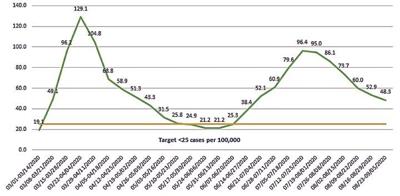After reaching nearly 100 cases per 100,000 people in late July the county has seen a decline in COVID-19 cases
Snohomish County COVID-19 case rate continues to drop but it is still above Washington state targets set for the next re-opening step.
Dr. Chris Spitters, Snohomish Health District Health Officer, gave an update on the county's status on Sept. 8.
The two-week rolling average has gone down to 48.3 cases per 100,000 people, however the target set by state officials to continue reopening steps is 25 cases per 100,000 people.
Snohomish County reached a peak of nearly 100 cases per 100,000 people at the end of July, but has had a steady decline in cases since then.
"We've had five straight weeks of successive decline," said Spitters. "Hospitalizations vary day-to-day but it's a long-term decline as well, so that's good."
Hospital occupancy had been above 70 percent, but has been lower for the past few weeks.
One of the other biggest problems for the county is contact investigation.
"We still have about 20 percent of cases that are not responding to our calls," said Spitters. "If you get a call that you think might be potential spam, please go ahead and answer. If it's a phishing attack please hang up, but if it's the health district stay on the line."
The county's performance is in line with other Puget Sound communities, however the state is setting targets at a 90 percent response rate for case investigations.
Currently, about 3.9 percent of COVID-19 tests come back positive.
"Our goal is to get around 2 percent, and that is getting better, but we still have a ways to go to reach that target," said Spitters.
Testing availability has been expanded, especially for those who need tests for employment requirements, healthcare/surgery requirements or for travel-related purposes.
"Our turnaround time is three to four days and there is no means for us to rush results to meet individuals' deadlines," said Spitters.
"So incorporate that delay into your planning," he said.
The availability of tests may be reduced in the future if demand outpaces capacity for them, said Spitters.
Testing is strongly encouraged for those who have a fever, shortness of breath, fatigue, muscle or body aches, headaches, sore throat, congestion, runny nose or those who have close contact to a confirmed case.
Updates about where testing is available can be found at snohd.org/503.
A former COVID-19 patient, local Maria Coghill, who is a 44-year-old in good health, also described her experience with the disease during the county update.
She said she contracted COVID in April, although her original test came back negative. "I could breath and my oxygen saturation was okay, but just taking a breath hurt," she said.
After a second test came back positive, she was sick in bed for two weeks.
"I didn't lose my sense of taste or smell until about a week in," she said.
"It wasn't until six weeks after my symptoms started that I could start to take walks again," she said, although initially her heart rate would shoot up quickly.
Other symptoms have appeared since them.
"It was toward the end of July where I've had Bell's palsy on one half of my face," said Coghill.
Bell's palsy is a weakness of muscles in one half of the face, which sometimes is experienced as paralysis, although Coghill does not have that symptom.
"I do continue to have bouts of fatigue and every once in a while my lungs will feel like a kitchen sponge," she said. "I feel really lucky. For the most part I've been able to resume my normal activities. Most of what I experience now is just a nuisance, but it is worrisome, especially as you hear about the people who have long-term impacts."
Spitters said doctors do not have full knowledge of what to expect for recovering patients, but lingering symptoms are not uncommon.
"It's not like the flu, where you get better and then a week later it's like it never happened," he said.
"We have limited experience knowing what the natural course of events for people recovering from COVID-19," he said.
The possibility of continuing symptoms is another reason to be careful and continue social distancing, he said.
"We want everyone to be aware of that. It's more motivation for us to try to prevent others from getting it," he said.
Finally, due to state wildfires, local air quality has been poor, said Spitters, and he advised anyone who has had a recent viral or bacterial lung infection, which includes COVID-19, to stay inside and limit activity.
"Groups that are most likely to be affected by this are those with underlying diseases of the heart or lungs, such as coronary artery disease, congestive heart failure, various rhythm failures," he said.


(0) comments
Welcome to the discussion.
Log In
Keep it Clean. Please avoid obscene, vulgar, lewd, racist or sexually-oriented language.
PLEASE TURN OFF YOUR CAPS LOCK.
Don't Threaten. Threats of harming another person will not be tolerated.
Be Truthful. Don't knowingly lie about anyone or anything.
Be Nice. No racism, sexism or any sort of -ism that is degrading to another person.
Be Proactive. Use the 'Report' link on each comment to let us know of abusive posts.
Share with Us. We'd love to hear eyewitness accounts, the history behind an article.